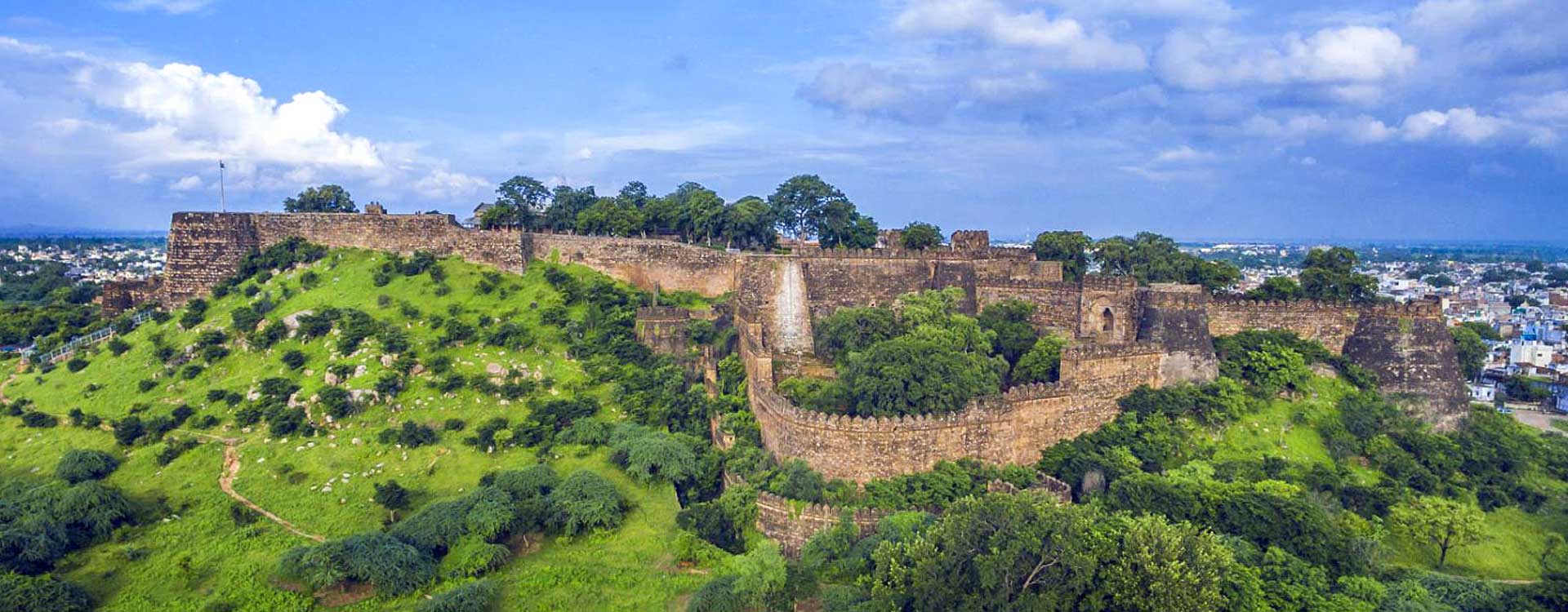Jhansi is a historic city in the Indian state of Uttar Pradesh. It lies in the region of Bundelkhand on the banks of the Pahuj River, in the extreme south of Uttar Pradesh. Jhansi is the administrative headquarters of Jhansi district and Jhansi division. Also called the Gateway to Bundelkhand, Jhansi is situated between the rivers Pahuj and Betwa at an average elevation of 285 metres. It is about 415 kilometres from New Delhi and 99 kilometres south of Gwalior. The original walled city grew around its stone fort which crowns a neighboring rock.
The ancient name of the city was Balwantnagar. From 1817 to 1854, Jhansi was the capital of the princely state of Jhansi which was ruled by Gurjar rajas. The state was annexed by the British Governor General in 1854; Damodar Rao's claim to the throne was rejected but Rani Lakshmibai ruled it from June 1857 to June 1858. Jhansi is well connected to all other major towns in Uttar Pradesh by road and railway networks. The National Highways Development Project has supported development of Jhansi.Jhansi is also being developed as the defence corridor by the NDA government which will boost the economy of the city and the region at the same time.
History
Jhansi was a stronghold of the Chandela kings. Balwant Nagar was the name of this place. But in 11th. century Jhansi lost its importance. In 17th. century under Raja Bir Singh Deo of Orchha Jhansi again rose to prominence. Raja Bir Singh Deo had good relations with the mughal emperor Jehangir. In 1613 Raja Bir Singh Deo constructed the Jhansi fort. He died in 1627. After his death his son Jujhar Singh succeeded him. Maharaja Chattrasal Bundela of Panna was a good administrator and a brave warrior. In 1729 Mohammed Khan Bangash attacked Chattrasal. Peshwa Baji Rao (I ) helped Maharaja Chattrasal and defeated mughal army. As a mark of gratitude Maharaja Chattrasal offered a part of his state to Maratha Peshwa Baji Rao(I). Jhansi was also included in this part.
In 1742 Naroshanker was made the subedar of Jhansi. During his tenure of 15 years he not only extended the Jhansi fort which was of strategic importance but also constructed some other buildings. The extended part of the fort is called Shankergarh. In 1757 Naroshanker was called back by the Peshwa. After him Madhav Govind Kakirde and then Babulal Kanahai were made the subedars of Jhansi. In 1766 Vishwas Rao Laxman was made the subedar of Jhansi. His period was from 1766 to 1769. After him Raghunath Rao (II) Newalkar was appointed the subedar of Jhansi. He was a very able administrator. He increased the revenue of the state. The MahaLakshmi Temple and the Raghunath Temple were built by him. For his own residence he constructed a beautiful building Rani Mahal in the city. In 1796 Raghunath Rao passed the subedari in favour of his brother ShivRao Hari.
In 1803 a treaty was signed between East India company and Maratha. After the death of Shiv Rao his grand son Ramchandra Rao was made subedar of Jhansi. He was not a good administrator. Ramchandra Rao died in 1835. After his death Raghunath Rao (III) was made his successor. In 1838 Raghunath Rao (III) also died. The British rulers then accepted Gangadhar Rao as the Raja of Jhansi. Due to the inefficient administration during the period of Raghunath Rao (III) the financial position of Jhansi was very critical.
Raja Gangadhar Rao was a very good administrator. He was very generous and full of sympathy. He gave very good administration to Jhansi. During his period the local population of Jhansi was very satisfied. In 1842 Raja Gangadhar Rao married Mannikarnika. After this marriage Mannikarnika was given the new name Lakshmi Bai, who led forces against British in 1857. She sacrificed her life to the cause of Indian Independence in 1858.
In 1861 the British Government gave the Jhansi fort and Jhansi city to JiyajiRao Scindia. Jhansi was then became a part of Gwalior state. In 1886 Britishers took back Jhansi from Gwalior state. In independent India Jhansi was included in Uttar Pradesh. At present Jhansi is a Divisional Commissioner’s Headquarter including district Jhansi, Lalitpur and Jalaun.
Places to Visit in Jhansi
Jhansi Fort
At a distance of 4 km from Jhansi Junction, Jhansi Fort or Jhansi ka Kila is an ancient and historical fortress situated in the heart of Jhansi, Uttar Pradesh. Atop Bangira hill, Jhansi Fort is the landmark of Jhansi town and also one of the top places to visit in Jhansi.
Jhansi Fort was built by Raja Bir Singh Deo of Orchha in 1613 CE and served as a stronghold of the Chandela Kings from 11th to 17th century AD. In the 18th century, Jhansi served as the capital of Maratha province and later the Princely State of Jhansi from 1804 to 1853 CE. The fort was the residence of the great Rani Lakshmi Bai of Jhansi, who fought the British East India Company during the 1857 War of Independence. This fort has been a witness to the fiery battle led by Rani Lakshmi Bai. During the mutiny, the queen and her army fought fiercely for two weeks.
Sprawling over an area of 15 acres, the fort is built in the north Indian style of architecture. Jhansi Fort has thick granite walls and several bastions with mounted cannons. Earlier, the wall of the fort used to surround the entire city of Jhansi and had ten gates. Some of these are Khanderao Gate, Datia Darwaza, Unnao Gate, Jharna Gate, Laxmi Gate, Sagar Gate, Orchha Gate, Sainyar Gate and Chand Gate. Many of the gates have disappeared with time, but some still stand and the places near the gates are still popular by the names of the gates.
Among the places of interest within the main fort area are Ganesh Mandir, Panch Mahal, Karak Bijli Cannon and Shiva Temple. Ganesh Mandir is the place where Rani Lakshmi Bai married Raja Gangadhar Rao and the Rani used to worship regularly. Karak Bijli is a lion headed canon measuring 5.5 meters by 1.8 meters and was operated by Ghulam Gauz, one of the faithful soldiers of Rani's army. The Fort also houses the Panch Mahal, which was the place where Rani Lakshmi Bai lived with her husband Raja Gangadhar Rao until his death. In the fort premises one can also see the Jumping Spot. From this place, Rani Lakshmi Bai fled with her son on the horseback when British surrounded the Fort of Jhansi.
Ram Raja Temple
The Ram Raja Temple is a temple in Orchha, Madhya Pradesh, India. It is a sacred Hindu pilgrimage and receives devotees in large numbers regularly and is also commonly known as Orchha Temple. The annual domestic tourist number is around 650,000 and the foreign tourist number is around 25,000.
Rani Mahal
The Rani Mahal is a royal palace in the city of Jhansi, Uttar Pradesh, India. At a distance of 4 km from Jhansi Junction, Rani Mahal is a royal palace located at the heart of Jhansi town in Uttar Pradesh. Situated close to Jhansi Fort, it is one of the famous Jhansi Tourist Places and also one of the top places to experience Jhansi Tourism.
Rani Mahal was built in 18th century AD by Raghu Nath-II of the Newalkar family. After the death of Raja Gangadhar Rao, Rani Lakshmi Bai used to reside in this palace. It is a flat- roofed double-storeyed building having a quadrangular courtyard with a small well and one fountain each on either side. The palace consists of arched chambers around an open courtyard that looks magnificent and is a welcome break from the typical architectures of Bundelkhand. Its major portion was damaged by British during the 1857 War of Independence.
The palace has a Durbar Hall located in the second floor that has a genuine painted wood-paneled ceiling. The interiors of the hall are very colorfully decorated with exquisite motifs of peacock, floral and geometric designs. The Rani Mahal has now been converted into a museum that houses various paintings, sculptures and objects collected from Madanpur, Barua Sagar, Dudhai and Chandpur dating from Gupta to Medieval period.
Rani Jhansi Museum
At a distance of 3 km from Jhansi Junction, Rani Jhansi Museum is a museum located inside the Fort of Jhansi. It is one of the important museums in Jhansi and also among the must visit places in Jhansi. Rani Jhansi Museum or Government Museum is not only gives an insight in to the history and heritage of Jhansi but also throws light on the history and culture of the Bundelkhand region. Dedicated to Rani Lakshmi Bai of Jhansi, this museum has an exclusive gallery on Rani Laxmi Bai and is a unique attraction. This section consists of lots of her armoury items and photographs, depicting her life since childhood.
It is also an important source to know about the life and times of the Chandela rulers. The Jhansi Museum houses weapons, statues, dresses and photographs that belong to the Chandela dynasty. The museum also houses a separate picture gallery that is dedicated to Gupta Kings. In fact, the picture gallery of the Gupta period is one of the highlights of this museum. Apart from that, the museum also houses numerous terracotta structures, bronze statues, manuscripts, paintings and coins. There is a separate gallery for weapons, which has an impressive collection of weaponry and arsenals used by Chandela Kings, Bundela rulers and the British. Some of the weapons used by Rani Lakshmi Bai and other fighters during the Sepoy Mutiny of 1857 are also kept here. There are paintings of many historical events & personalities in past history of India.
Cenoteph Of Raja Gangadhar Rao
At a distance of 2 km from Jhansi Fort and 5.5 km from Jhansi Junction, the Cenoteph of Raja Gangadhar Rao is located on the banks of Lakshmi Talab in Jhansi town of Uttar Pradesh. It is one of the famous heritage places in Jhansi and also one of the best places to visit in Jhansi.The Maharaja Gangadhar Rao Ki Chatri was dedicated to Maharaja Gangadhar Rao who was the king of Jhansi from 1836 CE - 1853 CE. He was the lover of the art and architecture and worked towards enriching the culture of Jhansi. He adopted the Son named Anand Rao in 1853, who he taught would be the next crown prince. Raja Gangadhar Rao expired the very next day leaving behind son and wife.
The Chatri was built by his wife Maharani Lakshmi Bai after his death. The Chatri is set within a quadrangular walled structure and has two domed structures. They are approached by a small flight of stairs. The tomb has scriptures around and is covered with a beautiful garden and flowers.
Lakshmi Tal or Talab is a beautiful pond, famous for educating of cultural activities of the inhabitants of Jhansi. At the edge of Lakshmi Tal is situated the magnificent Lakshmi Temple, built in 18th century. The temple is dedicated to Goddess Lakshmi and was built like a palace. It is said that the queen Lakshmi Bai used to come to the temple by boat from the Lakshmi gate every Friday for offering prayers. At present the temple is under the maintenance of the State Archaeology Department. The temple attracts large number of crowd during the Lakshmi Puja in Diwali.
St. Jude's Shrine
At a distance of 2 km from Jhansi Junction, St. Jude's Shrine is a Roman Catholic Church located in the Cantonment area of Jhansi town in Uttar Pradesh. It is one of the holiest places in Jhansi mainly for Catholic Christians and also one of the popular places to visit in Jhansi.
St. Jude's' Shrine is devoted to St. Jude Thaddeus and is part of the Roman Catholic Diocese of Jhansi. The devotion to St. Jude Thaddeus was started by the late Bishop F. X. Fenech. It is believed that the bone of St. Jude is buried in its foundation. The well painted statues in the shrine depict the great story of Jesus Christ. There is also a separate shrine for mother Marry in its premises. St. Jude's feast is celebrated on 28th October every year which attracts large number of devotees from far places. It is celebrated with a week-long fair and procession on the last day with great enthusiasm.
Chaturbhuj Temple
Chaturbhuj Temple, dedicated to Vishnu, is situated at Orchha in Madhya Pradesh, India. The name Chaturbhuj is where 'chatur' चतु: meaning "four" and 'bhuj' भुजा meaning "arms" which literally translates to "one who has four arms" and refers to Rama an avatar of Vishnu.
Barua Sagar
At a distance of 24 km from Jhansi Junction, Barua Sagar is a town and a municipal board in Jhansi district of Uttar Pradesh. Many monuments, temples and forts adorn Barua Sagar which reminisces the ancient and the historical past.The town got its name from the beautiful Barua Sagar Lake. Barua Sagar is an artificial lake built by the King of Orchha, Raja Udit Singh about 260 years ago. He also built embankments around this beautiful lake. The place is also famous for being the battleground of the Bundelas and the Marathas in 1744 AD. There is a temple dedicated to Sage Shringarishi on the banks of the lake. A fort, now in ruins, was also built by Raja Udit Singh on the banks of this lake. The fort commands an excellent view of Barua Sagar Lake and the surrounding landscapes.
There are ruins of two Chandela period temples, locally known as Ghughua Math and Jarai Ka Math. Ghughua Math is built in granite and has four cells, each fitted with doorways, of which three have an image of Ganesh and the fourth has an image of Durga. Jarai Ka Math is an east facing temple located in the outskirts of Barua Sagar Town, on Jhansi-Mauranipur road. The temple consists of a sanctum, antarala and a ruined mukha-mandapa.
Jarai Ka Math is probably one of the most popular temples in Barua Sagar that was built during the times of Pratiharas in 860 AD. Parts of the temple have been severely damaged and some have been rebuilt during the Bundelas in 17th Century. The intricate carvings on the exterior, the fine engravings of different forms of Goddess Durga are the main highlight of this temple architecture. This temple has been listed by the Archaeological Survey of India as a finest example of Pratihara architecture.
How to Reach Jhansi
Jhansi is located in the state of Uttar Pradesh. It does not have an airport but is well-connected by road to Gwalior. It is also connected by rail and road to major destinations like Mumbai, Agra, Delhi, Chennai, Bengaluru, and Hyderabad. Here is how to reach Jhansi:
By Air
At 103 km from Jhansi, Rajmata Vijaya Raje Scindia Air Terminal, Gwalior is the nearest airport. Flights from Mumbai, Delhi and Jabalpur connect to Gwalior. Delhi is the closest international airport, 321 km from Jhansi. Most major cities across the world are connected to Delhi by air.
By Train
Jhansi is an important railhead on the Delhi-Chennai route. Most major cities in the country like Mumbai, Delhi, Chennai, Bengaluru, Hyderabad, Pune, Agra, Ahmadabad, Bhopal, Jammu, Mangalore, Gorakhpur, Mysore, Surat, Varanasi, Trivandrum, Gwalior, Dehradun, Ujjain, Indore, Jabalpur, Secundrabad, etc. are connected to Jhansi by rail.
By Road
Jhansi is well connected by road to many major cities in the country. Cities like Agra, Khajurao, Delhi, Kanpur, Lucknow, etc. are easily accessible from Jhansi by road. Public and private buses connect Jhansi to major neighbouring cities. Buses ply daily from Gwalior and Khajurao to Jhansi. Buses also connect Delhi to Jhansi.
Best Time to Visit Jhansi
The best time to visit the place is from November to March when the weather remains pleasant and calm. A number of tourists also visit the place during February, when the Jhansi Festival is organized.
Most of the visitors are visiting during the winter in Jhansi. During winters, the weather remains cold and pleasant. It is the perfect season to explore the place and visit its attractions like Fort of Jhansi, Barua Sagar, Jhansi Museum, Ganesh Mandir and Rani Mahal.






